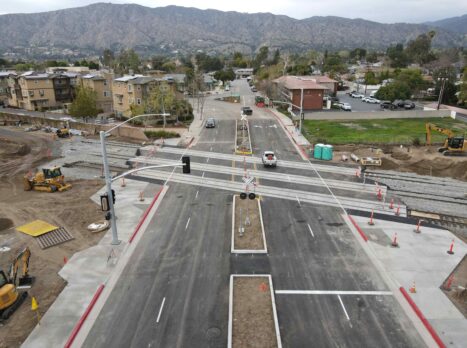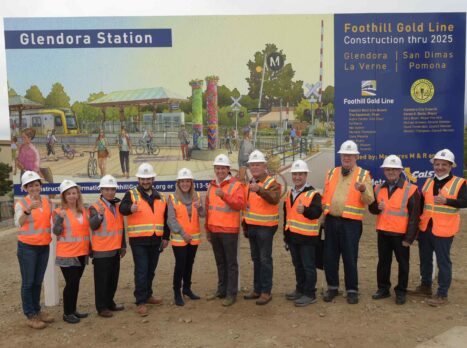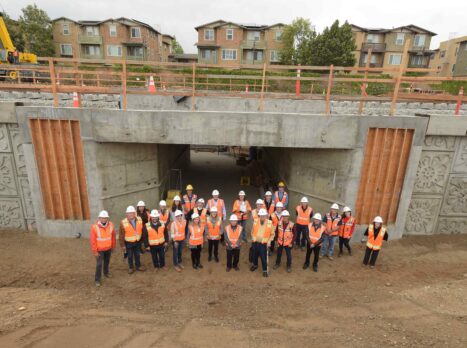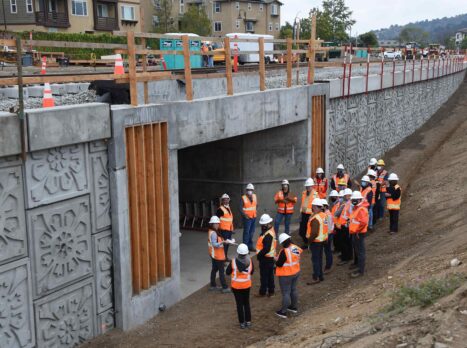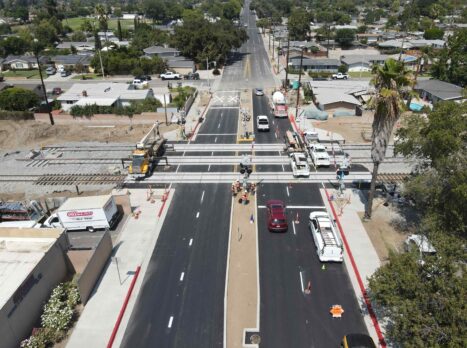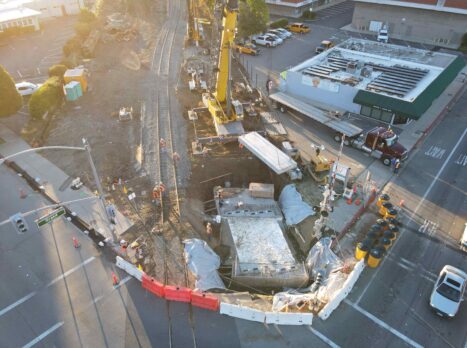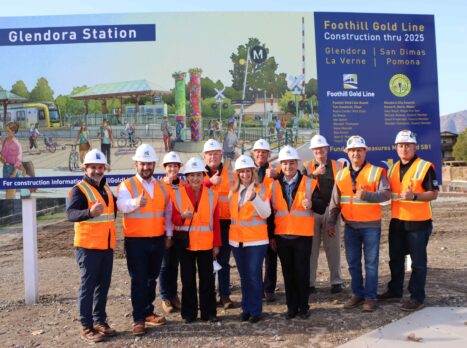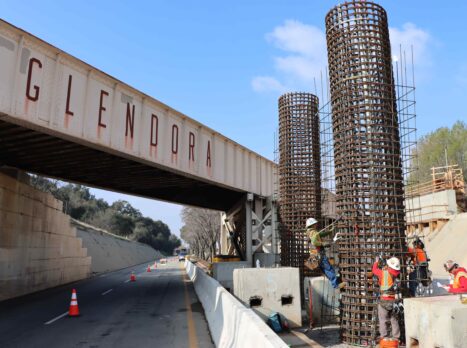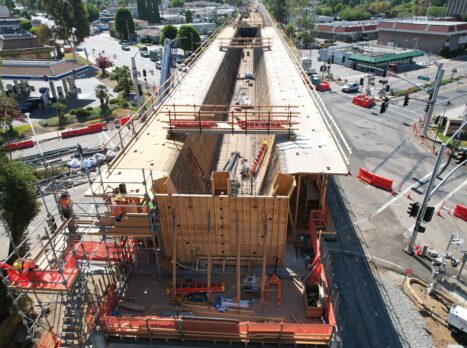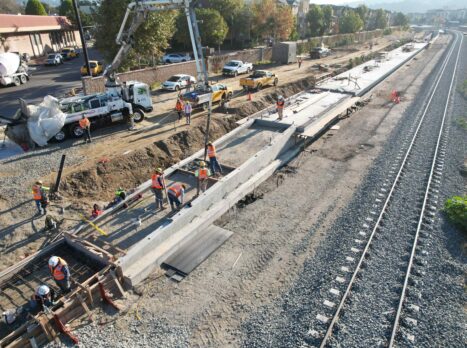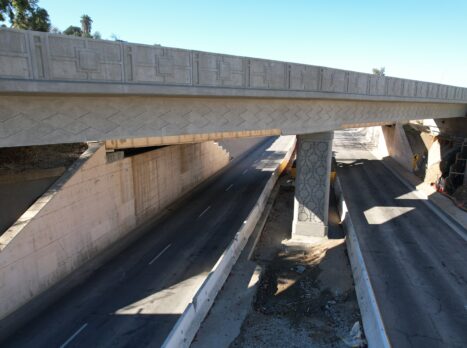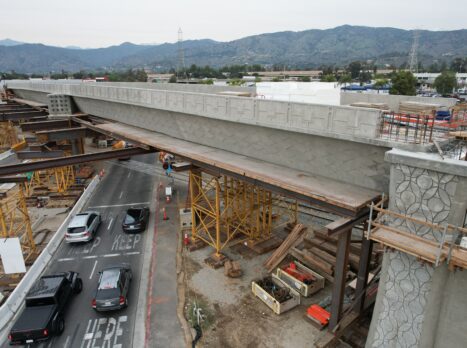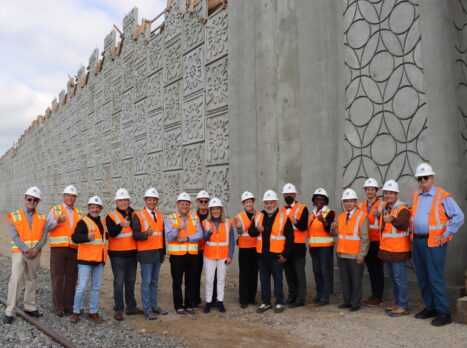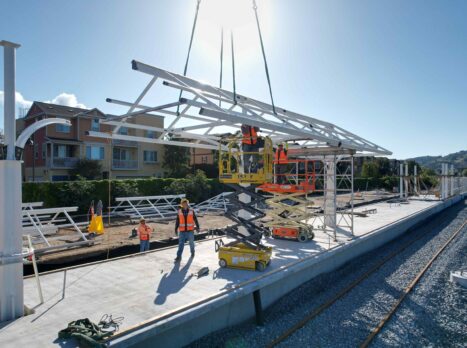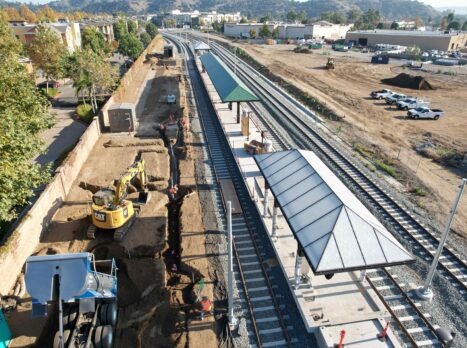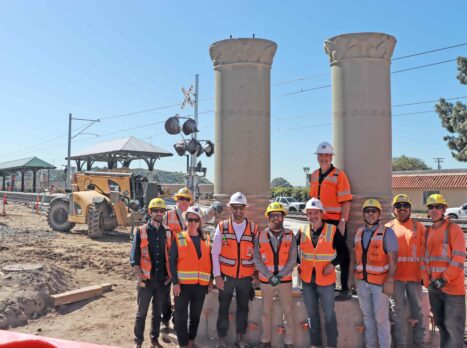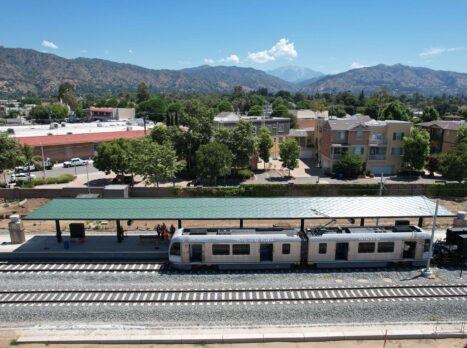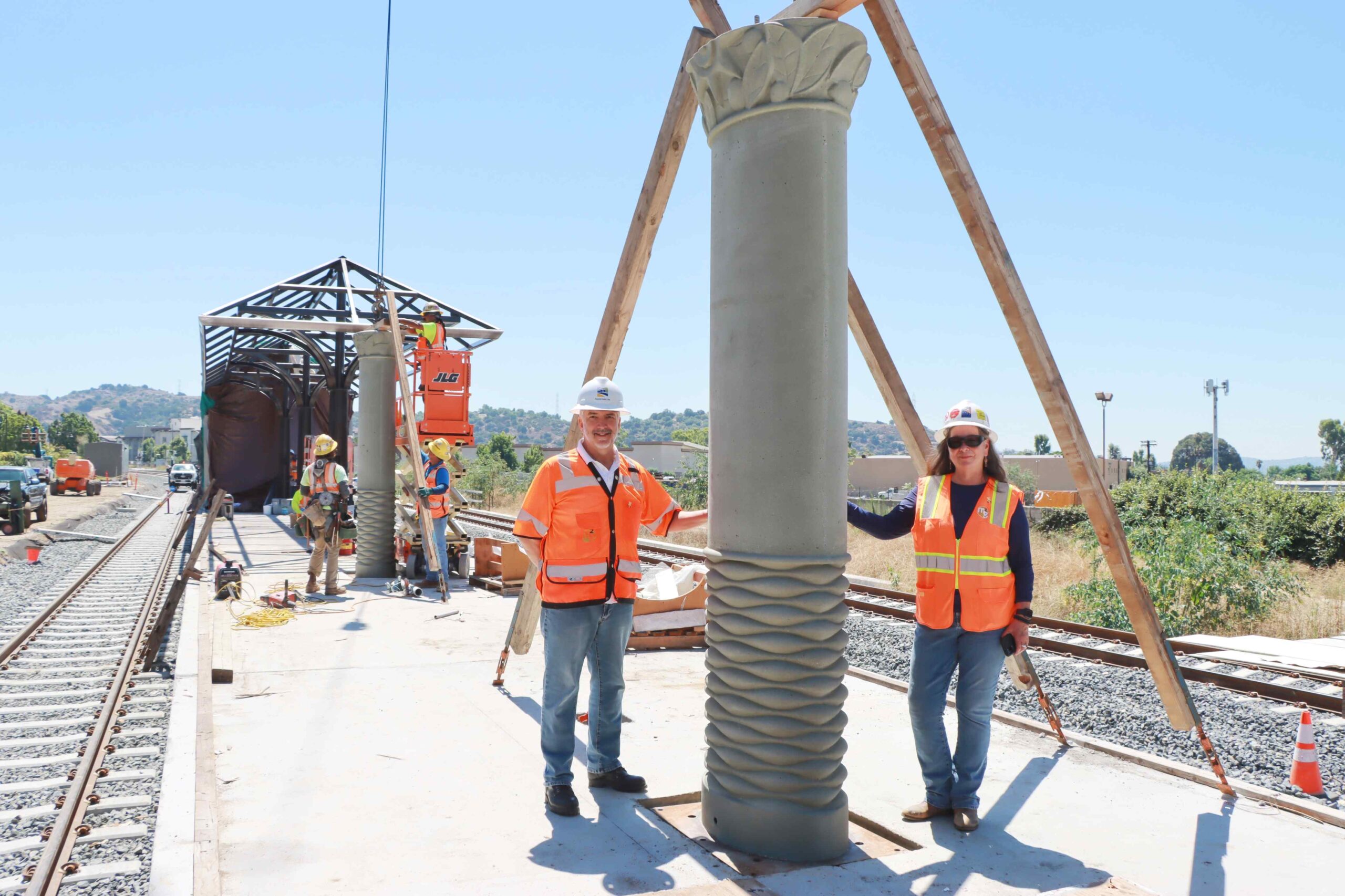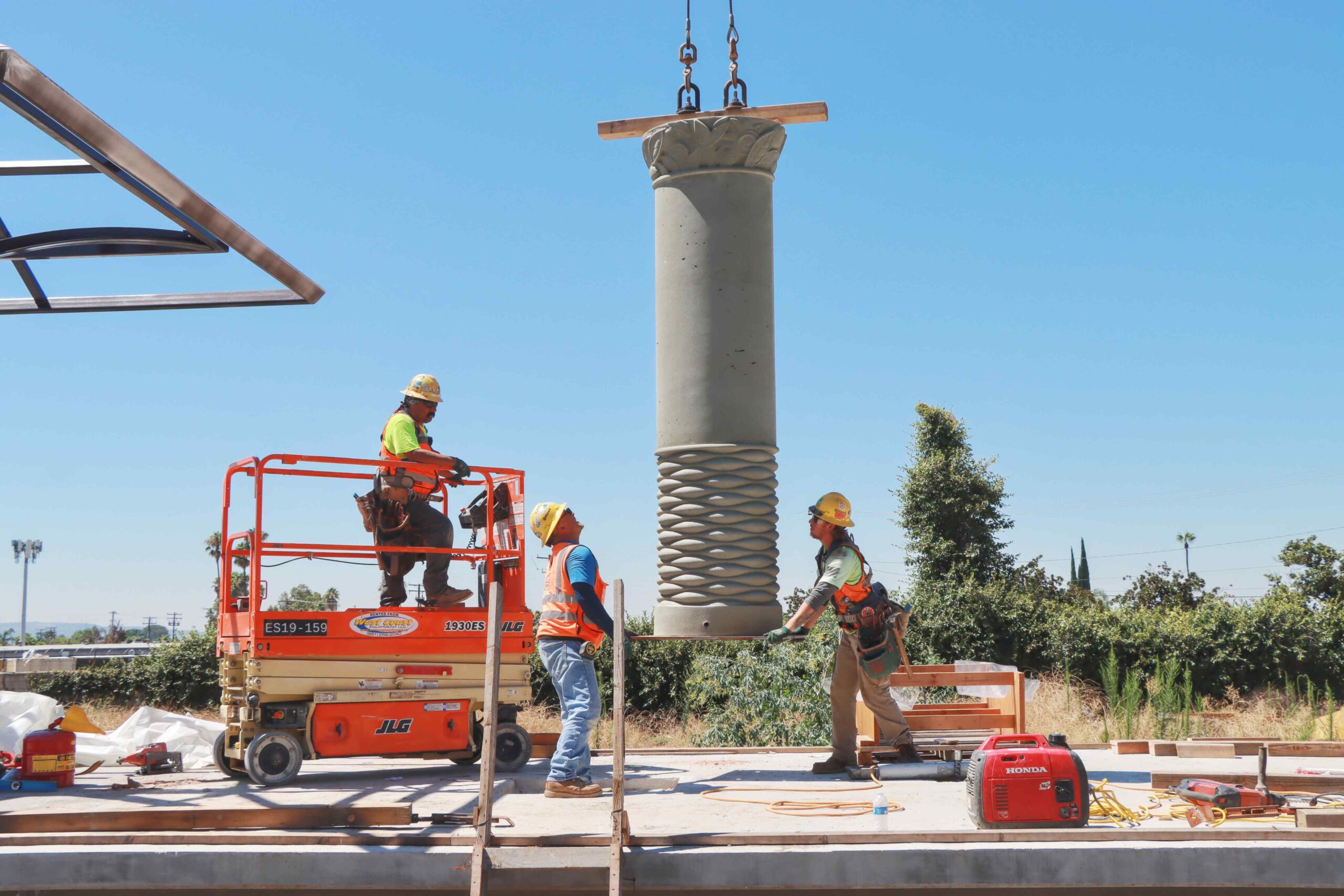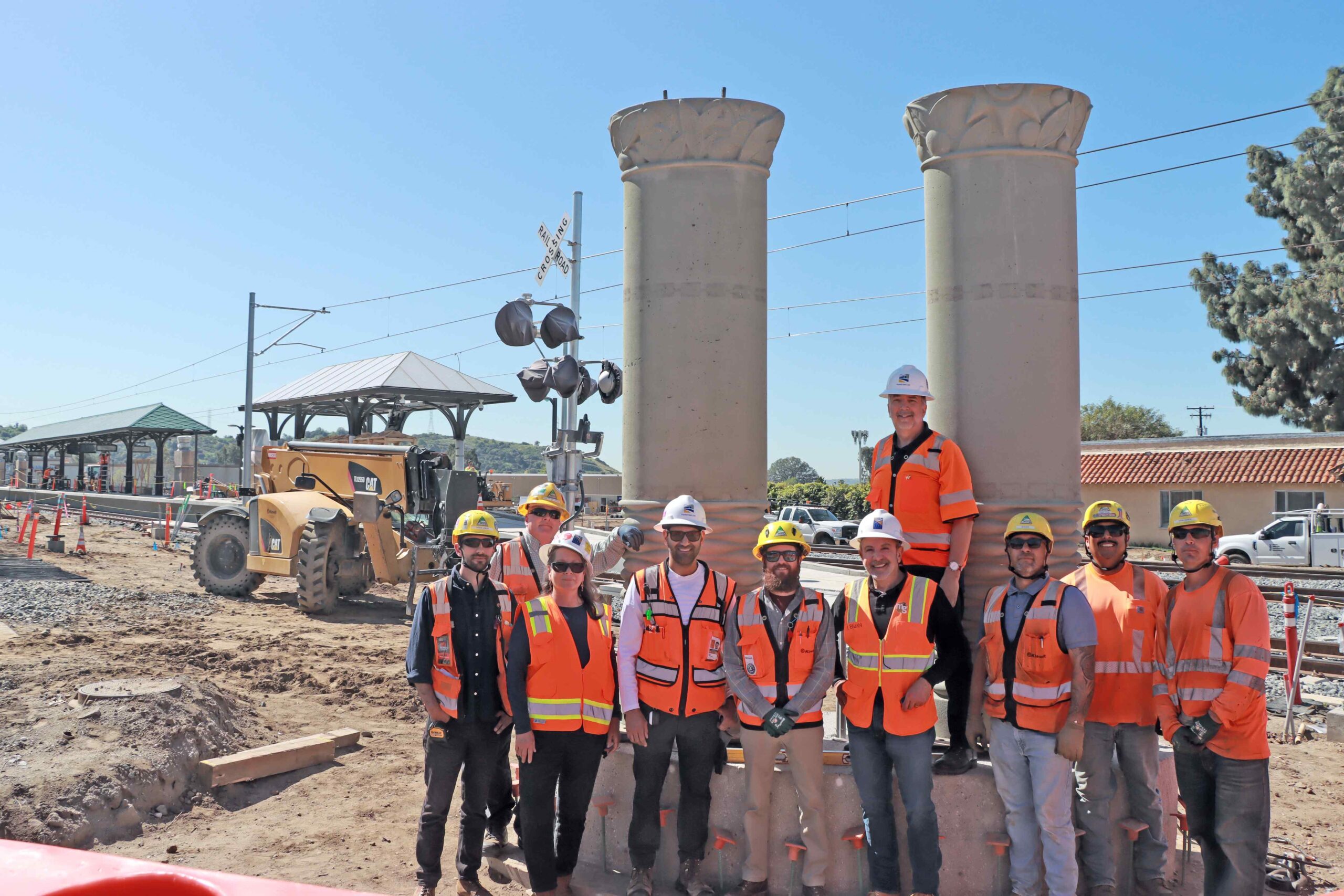renderings site plan photos
Glendora Station
The Glendora Station and associated 302-space parking facility (with charging stations for EVs, bicycle parking, and bus and drop-off areas) is located just south of the city’s historic downtown, east of Vermont Avenue and west of Glendora Avenue. The center platform station has light rail tracks on either side (one for westbound and one for eastbound trains). Once completed, three tracks will run through the City of Glendora within one shared corridor – with two light rail tracks on the north side for the A Line, and one track for freight on the south. While they will share the rail corridor, light rail trains and freight trains do not share tracks.
During the remaining construction, the community can expect temporary impacts (such as short-term lane closures, noise mostly from construction vehicles, and other construction- related issues). Permanent changes are occurring due to the project, including: safety enhancements at all street crossings (raised medians, red curbing and turn restrictions within 100 feet of the rail corridor at all street crossings), relocation of the freight track to the southern half of the rail corridor, new fencing and walls along the entire rail corridor, and new overhead wires to power the more than 200 light rail trains anticipated to run daily. New light rail bridges are now complete over the Foothill Boulevard/Grand Avenue intersection, at Lone Hill Avenue and at Route 66 for light rail trains only (the existing Route 66 freight bridge will remain and be repainted as part of the project). A traffic signal will be installed at the intersection of Elwood Avenue and Foothill Boulevard. West Ada Avenue (west of Vermont Avenue) and Glenwood Avenue have been permanently closed and made into cul-de-sacs at the railroad corridor, as required by the California Public Utilities Commission to improve safety along the corridor.
Once completed, a trip from Glendora to Pasadena will take approximately 22 minutes and further to downtown Los Angeles will take approximately 51 minutes.
Light Rail Bridges at Foothill Boulevard/Grand Avenue intersection, Lone Hill Avenue and Route 66
The California Public Utilities Commission (CPUC) is responsible for reviewing and approving all grade crossings in the State of California where a train is proposed to cross a street or pedestrian walkway. As part of the CPUC’s extensive review process for the Foothill Gold Line project, the regulatory agency has required that new bridges be built over the intersection of Foothill Boulevard/Grand Avenue and Lone Hill Avenue in the city of Glendora for the Gold Line only. The bridges are being required for safety of both the new light rail system and the city streets; as the result of an estimated 200+ light rail trains crossing the intersection and street each day in the future.
At the Foothill Boulevard/Grand Avenue intersection, the existing freight track has been relocated within the existing railroad corridor and will remain at street level; and the intersection was reconfigured to improve safety and visibility. Click here for more information on the Gold Line bridge over the Foothill Boulevard/Grand Avenue intersection.
At Lone Hill Avenue, the existing freight track has been relocated within the existing railroad corridor and will remain at street level; and the grade crossing was reconfigured to improve safety and visibility. Click here for more information on the Gold Line bridge over Lone Hill Avenue.
At Route 66, the existing freight bridge and track will remain in its current location, while a new light rail bridge for the light rail system was built directly adjacent to the freight bridge on the north side. Click here for more information on the Gold Line bridge over Route 66.
For more information on the station, including the public art planned, click here for the latest station fact sheet.
About the Artist
Michael Hillman is an accomplished local artist, and arts educator, with an extensive resume of public art projects completed in California. In, 2004, Michael received a grant for the Visiting Artist Program at Citrus College; the artist and his students designed and created a bench and two hand-made tile wall murals on campus. His resume includes several local projects that are within private development sites. He received the distinguished faculty award from Citrus College and has developed curriculum for study abroad trips to Italy.
Michael received a Masters of Art & Ceramics degree from Cal State Long Beach. His experience includes teaching as a Professor of Art at Citrus Community College since 1997. He previously served as a Professor of Art at Azusa Pacific University and was an art consultant for the J. Paul Getty Museum. Hillman has also served on the advisory board for the Los Angeles County Museum of Art.
Station Art Plan
Michael’s plan for the station art is derived from the rich history of the town in which he lives and works: Glendora. “Glendora Home: A Slice of Sunshine” is the title of Michael’s theme for the station and refers to a brand of citrus that was grown and packed in Glendora and the company’s slogan: “A Slice of Sunshine.” The title also reflects the artist’s feelings about Glendora.
Based on his design concept, Michael was selected by the city Glendora’s Station Design and Art Review (SDAR) Committee, later ratified by the city council, in 2005. Michael draws from the history, culture and landscape of the city to develop the art for the Glendora Station that he hopes will encourage passengers, especially those from the area, to reminisce. Michael’s designs will interpret local themes in a contemporary way, while referencing stylistic influences of Gaudi and Escher. He has designed eight station landmarks, which are large, oval columns based on the Fibonacci rules embellished using dazzling glass tesserae tiles in brilliant colors to depict imagery (including citrus, the foothills, bougainvillea, the brodiaea filifiolia flower and water). These sculptural columns will be placed in the platform and in station entry plazas. The canopy bases will be embellished with hand glazed cuerda seca imagery in various patterns, pinwheel, tessellation and drop & slide.
For more information on the artist and artwork, click here for the latest station fact sheet.
Future Plans
During 2006-7, the Construction Authority worked with the City of Glendora (along with all other Foothill Gold Line cities from Pasadena to Montclair) to explore their visions for integrating transit oriented developments (TOD) near the future station. At that time, the city was laying the groundwork for TOD near the future station by updating the city’s General Plan and Route 66 Specific Plan, and identifying opportunity sites for mixed-use development. The Construction Authority and city began a new dialogue through another TOD study in 2010, which revisited the earlier concepts following the economic downturn. In 2016, the Construction Authority measured the progress of TOD implementation since the first segment of the line opened for passenger service in 2003, including reviewing the potential TOD that could take place near the stations looking forward. Click here to learn more about the TOD Studies.
First/Last Mile Plans
The first/last mile plan for the future Glendora station is overseen by Metro. Metro coordinated with the Construction Authority and City of Glendora to create a first/last mile plan for the Glendora station area. The plan was adopted by the Metro Board of Directors on June 27, 2019.
To learn more about the first/last mile plan for the future Glendora station, click here to visit Metro’s first/last mile plan website. NOTE: If you click on the link, you will be directed away from this website.
About Glendora
Glendora is nestled at the base of the scenic San Gabriel Mountains, in the eastern portion of Los Angeles County. Located approximately 27 miles from downtown Los Angeles, Glendora offers convenient access to major commercial, cultural, educational and recreational areas in Southern California. Founded in 1887, Glendora was officially incorporated as a City in 1911. The City remained a small citrus-producing community until the late 1950s, when agriculture gave way to large scale residential development.
Today, over 50,000 residents enjoy Glendora’s highly rated public and private schools, lush parks, comprehensive community services and one of the lowest crime rates in the nation. From tree lined neighborhood streets and quaint downtown Village shops to the modern architecture of the Financial Way business center, Glendora is a haven from the fast pace of the Los Angeles metropolitan area.
Learn more:
Citrus College – www.citruscollege.edu
City of Glendora – www.ci.glendora.ca.us
East Valley College – http://www.eastvalleycollege.com/
East Valley Hospital Medical Center – http://evhmc.com
Foothill Presbyterian Memorial Hospital – https://www.cvhp.org/Our_Facilities/Foothill_Presbyterian.aspx
Glendora Chamber of Commerce – www.glendora-chamber.org
Glendora Community Hospital – https://www.glendorahospital.com/
Glendora Historical Society Museum – www.glendorahistoricalsociety.org
Glendora Village – www.glendoravillage.com
Haugh Performing Arts Center – http://www.haughpac.com/
South Hills Wilderness Area – http://www.cityofglendora.org/departments-services/parks-recreation-senior-services/trails
The Rubel Castle & Pharm – www.glendorahistoricalsociety.org


-467x348.jpg)


















